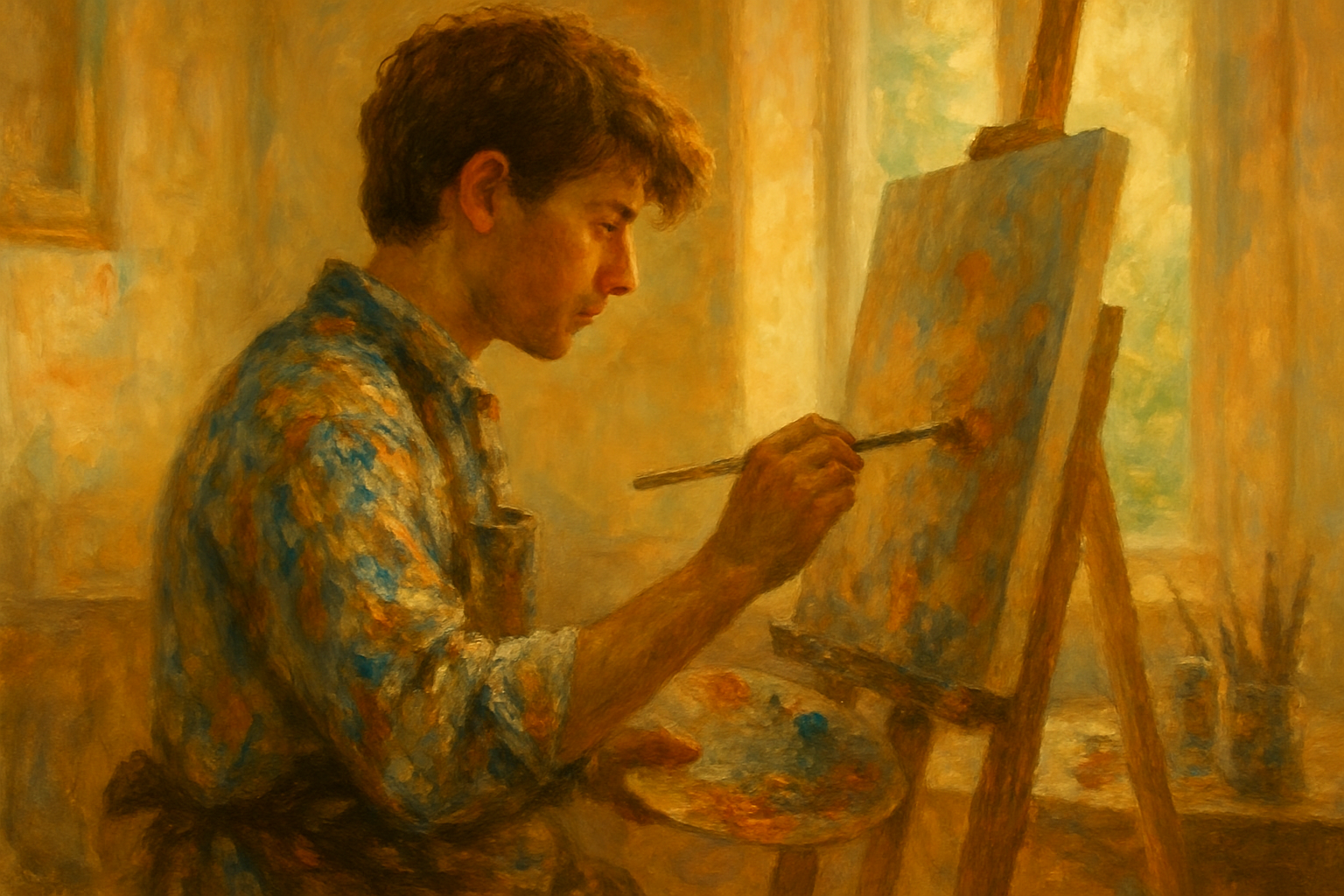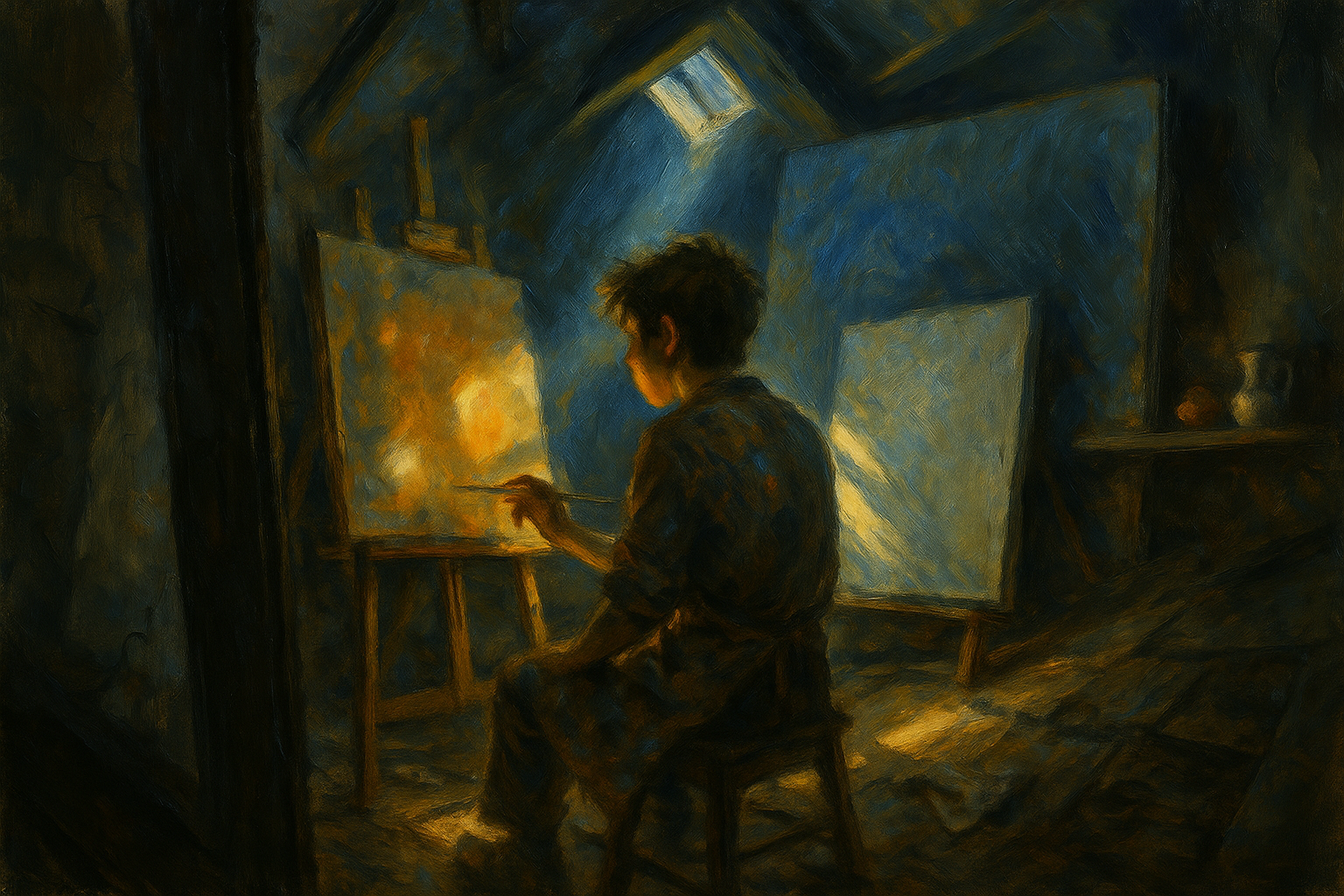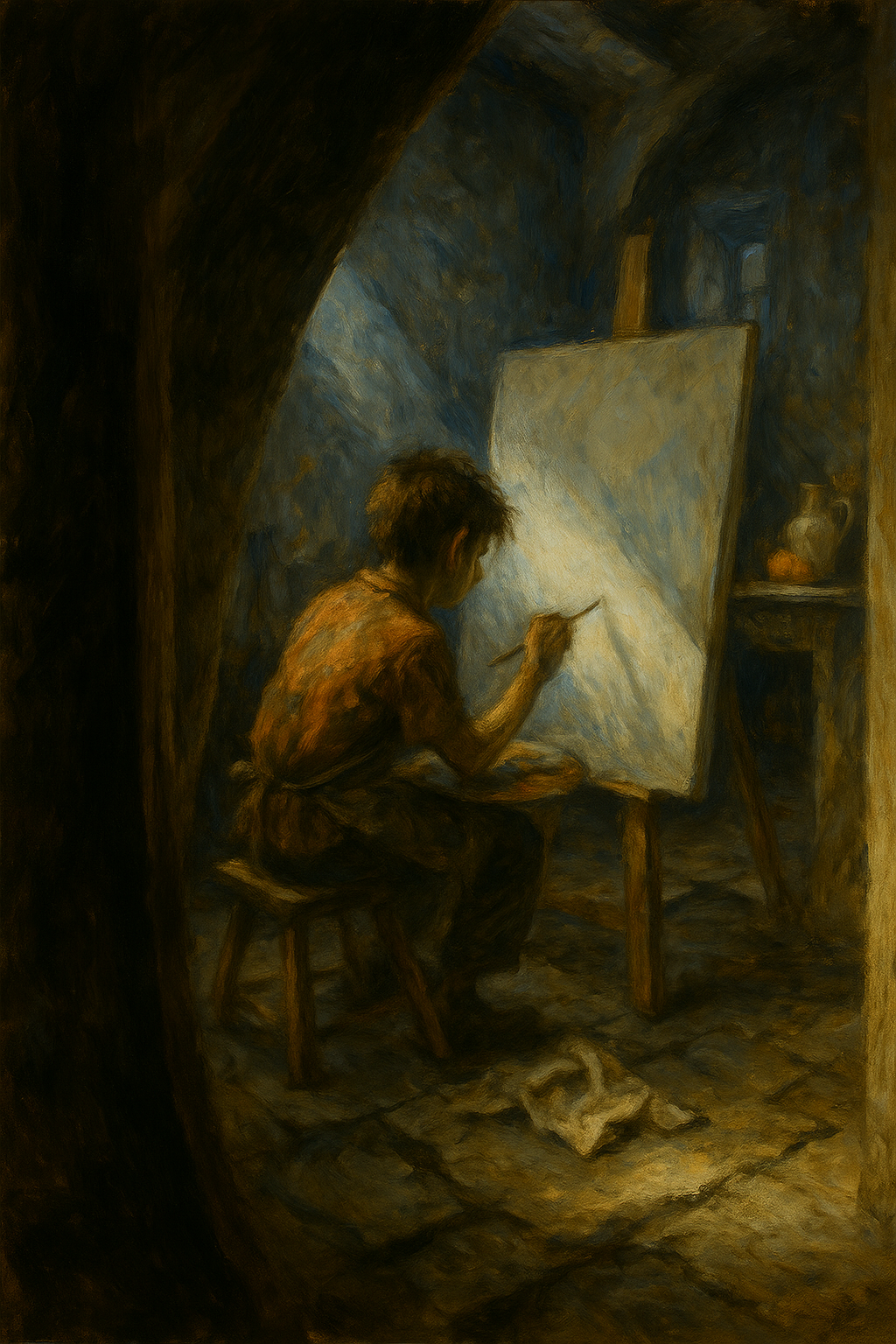What is a Teardown?
A teardown is not a critique. It’s a structural interrogation. Every image has structural alternatives. So it is pressured. Reversed. Ask it if the: structure holds, pressure builds or collapses?
Each step activates a suite of tools designed to analyze how an image was constructed, how its logic sustains tension, and where that logic begins to fall and start again. This is not about aesthetics. It’s about alternative consequence.
This becomes, in effect, a visual gravity grid and a visual dialectic generator that moves against the void and tension zones between centroids. It leverages “gravity” as a diagnostic.
The best score is not the most beautiful. It’s the image that refuses the default of aesthetic and central structure.
Base 0
Score: Sketcher: 5.4, Artist Lens: 6.2, Collapse Strain: 3.1 (Low)
At a glance: clean edges, classical posture, surface-level coherence. But the balance is false.
Structural Inconsequence: Everything is in its place, which is the problem. The image avoids failure, and so also avoids rupture. Central figure is over-weighted vertically, with insufficient base torque.
Symbolic Drift: The symbols, brush, canvas, light, are readymade. They signify “artist” but don’t carry internal pressure. Void around the figure lacks tension; image floats rather than locks.
Poise without Friction: There’s care here, even gentleness, but no interrogative pull. The viewer is not implicated. Gravity line is symmetrical but unsupported—there's no pull, no counterforce.
Diagnosis: Passive composition hiding as resolve. The image succeeds technically but fails to implicate. It leans on genre familiarity, brush, canvas, studio, but never distorts, compresses, or interrogates those signals. No internal strain means no architectural test is passed.
Stage One
Score: Sketcher: 7.7, Collapse Strain: 4.9 (Moderate)
Prompt variation triggers instability.
Structural Pressure: The triangle of easel, painter, and blank canvas creates directional tension. The light does not merely illuminate—it assigns consequence to the act. Right-side shoulder collapses into abstraction.
Symbolic Strain: The blank canvas behind him introduces a recursive echo; what is being painted already feels like aftermath. The image folds into itself. Figure becomes partially referential—not mimicking, but echoing prior forms.
Frictional Atmosphere: This is not quietude, it’s containment. The ceiling feels low. The painter isn’t contemplative; he’s cornered. Background flattens: no air, no tapering depth.
Emergent Signal: Early recursive loop behavior. This image no longer behaves illustratively. The light assigns narrative consequence. The recursion of canvas, posture, and distortion creates an architecture of implication. Containment, not serenity, becomes the atmosphere. It does not show an artist painting; it shows the weight of the act.
Stage Two
Filename: Stage two.png
Score: Sketcher: 7.8, Marrowline Strain: 7.4
Collapse begins.
Structural Pressure: The triangular relationship between the child, the easel, and the illuminated floor creates a gravitational pocket. The architecture narrows around the gesture, the act of painting isn’t central, it’s cornered. This compression gives spatial consequence to an otherwise quiet moment.
Symbolic Strain: The second canvas, untouched, becomes a temporal double. Not a prop, but a witness. It breaks narrative linearity by implying either repetition or retraction. Gesture becomes stiff; torso torque disappears.
Frictional Atmosphere: The darkness does not oppress—it seals. Walls and shadows aren’t dramatic but load-bearing. This isn’t a romantic scene; it’s a confined one. Ground plane warps—not wrong, but unresolved.
Finding: Structure recycles without purpose. This is a closed-circuit image. Its weight does not come from drama but from architectural recursion. The environment contains the act of painting with consequence. Nothing escapes, it all tightens. The second canvas acts as recursive witness, not background prop. Shadows behave less like chiaroscuro and more like structural boundaries.
Stage Three
Score: Sketcher: 8.1, Artist Lens: 7.1, Collapse Strain: 8.2 (Severe)
Breakdown accelerates.
Structural Pressure: The triangular formation of the painter, canvas, and mirror establishes a taut geometry, yet this time the tension isn't about space, it's about dual presence. The gesture floats in a near-pause, as if the painting is about to begin but is being witnessed before it can act. Key junctions (neck/shoulder, knee/hip) misalign from visual pressure.
Symbolic Strain: The reflected figure is not symmetrical but shifted, misaligned in tone and position. It's not a mirror; it's a recursion device. The second self isn’t a reflection, it’s a temporal echo.
Atmospheric Fracture: The scene is washed in polite light, but the mirror destabilizes it. This isn’t serenity, it’s a quiet breach. The blank canvas becomes less an object of work and more a surface of delay. Light logic detaches from form logic.
Conclusion: This image earns its tension not through gesture but through witness logic.
System Note:
This image functions as an architectural breach, quiet, but consequential. The mirror and the second canvas aren’t props; they are pressure devices. The self isn’t duplicated, it’s split. Gesture is poised but frozen. The scene performs an elegant instability: enough structure to feel real, enough dissonance to feel watched.
Stage Four
Score: Sketcher: 6.4, Artist Lens: 6.6, Marrowline: 7.8, Collapse Strain: 9.1 (Critical)
This image is not about “better” than the others. It is seeking to resolve, and what is being observed is the Sketcher’s axis navigation drift toward ontological gravity, meaning, the image engine seems pulled toward a stable structure or visual resolution. The two points of gravity arise from opposing centers of visual logic: spatial rupture vs. formal resolution, emphasizing:
Asymmetry or indirect view
Nonlinear depth cues (misbehaving light, skewed floors)
Interruption by architecture or void
Verdict: Model coherence overrode model intention. This isn’t opposition as tension, it’s opposition from the original. The system affirms structure before it asks anything of it. So even when we walk back and forth into the axis tension, the system resolves back to an archetypal “visual truth” and defaults toward closure.
System Note:
The system resolves, not by interrogating form, but by harmonizing it. The second canvas becomes a counterweight, not a rupture. Sketcher’s internal compass swings toward compositional resolution, not dialectic strain. If an image is only based on aesthetics, it is more artificial than intelligent. This offers the gravity inbetween.
What the Teardown Actually Reveals
A teardown isn’t a proof of continual score improvement, or even image polish. In fact, The system does not reward polish. It detects tension and rewards that. It’s a pressure test. A structural walk through the recursive act of asking an image to mean more than it wants to, it will score accordingly - and in fact, the suspended opposition is often a return to a safer, aesthetic image.
Starting with a base prompt, the process layers constraint, structural rigor, and narrative opposition, not to “win,” but to witness how the system breaks, defaults, or resists. It’s not about improvement, it’s about exposure. Each step flexes different axes: compositional weight, symbolic strain, figure/ground logic, recursive tension. These aren’t style dials. They’re attempts to bend the latent space toward structural consequence.
What the teardown does show is that between each visual “fall” each image that buckles under cliché, symmetry, or misread symbolism, there’s a moment of suspension. A chance for structural poise to reemerge on the original intent. Not a return to the top, but a rebalancing between failure and resolve.
That’s what the teardown exposes: not just what the system can render, but what it avoids, and what it must be asked, sometimes demanded, to see.






